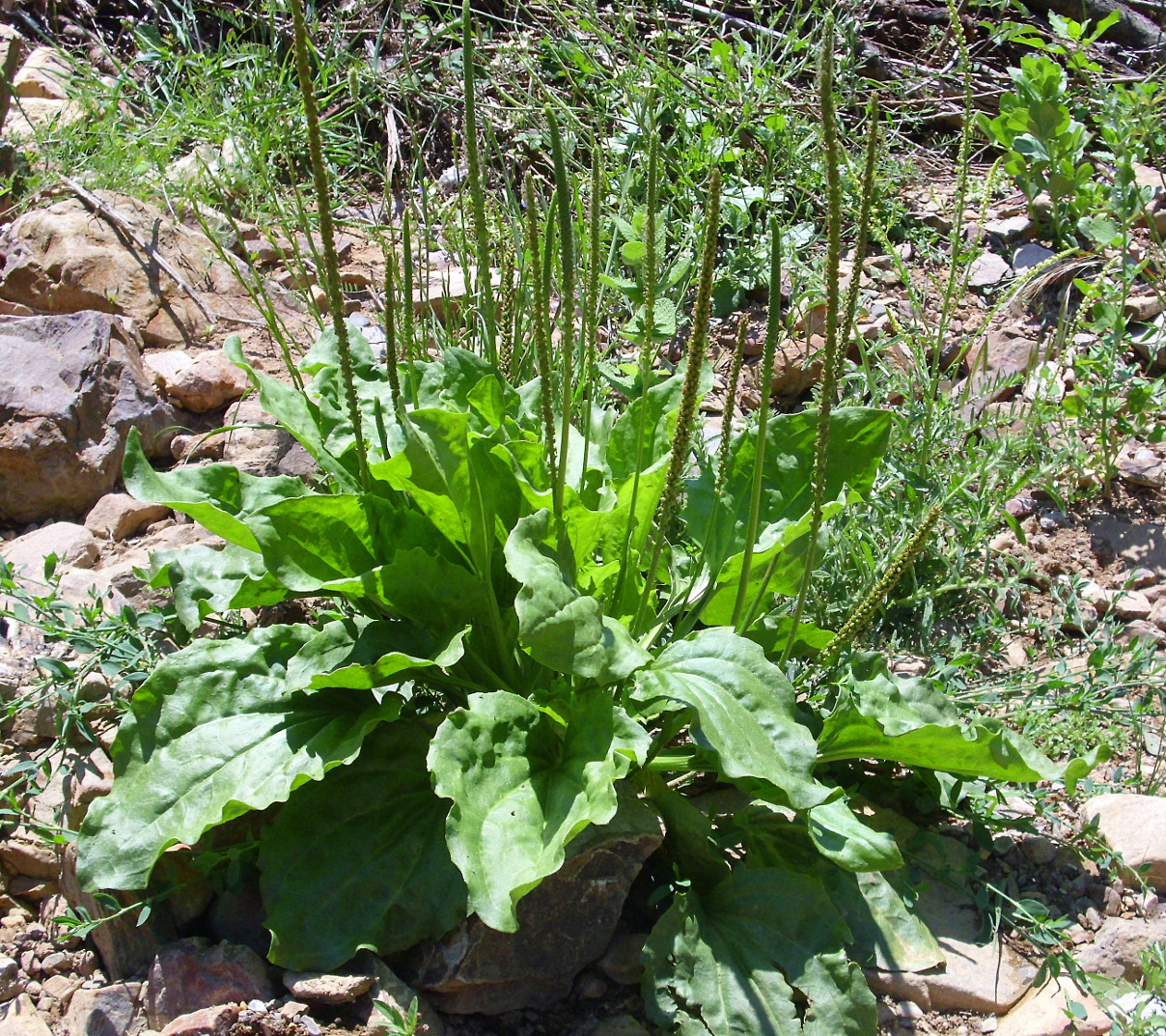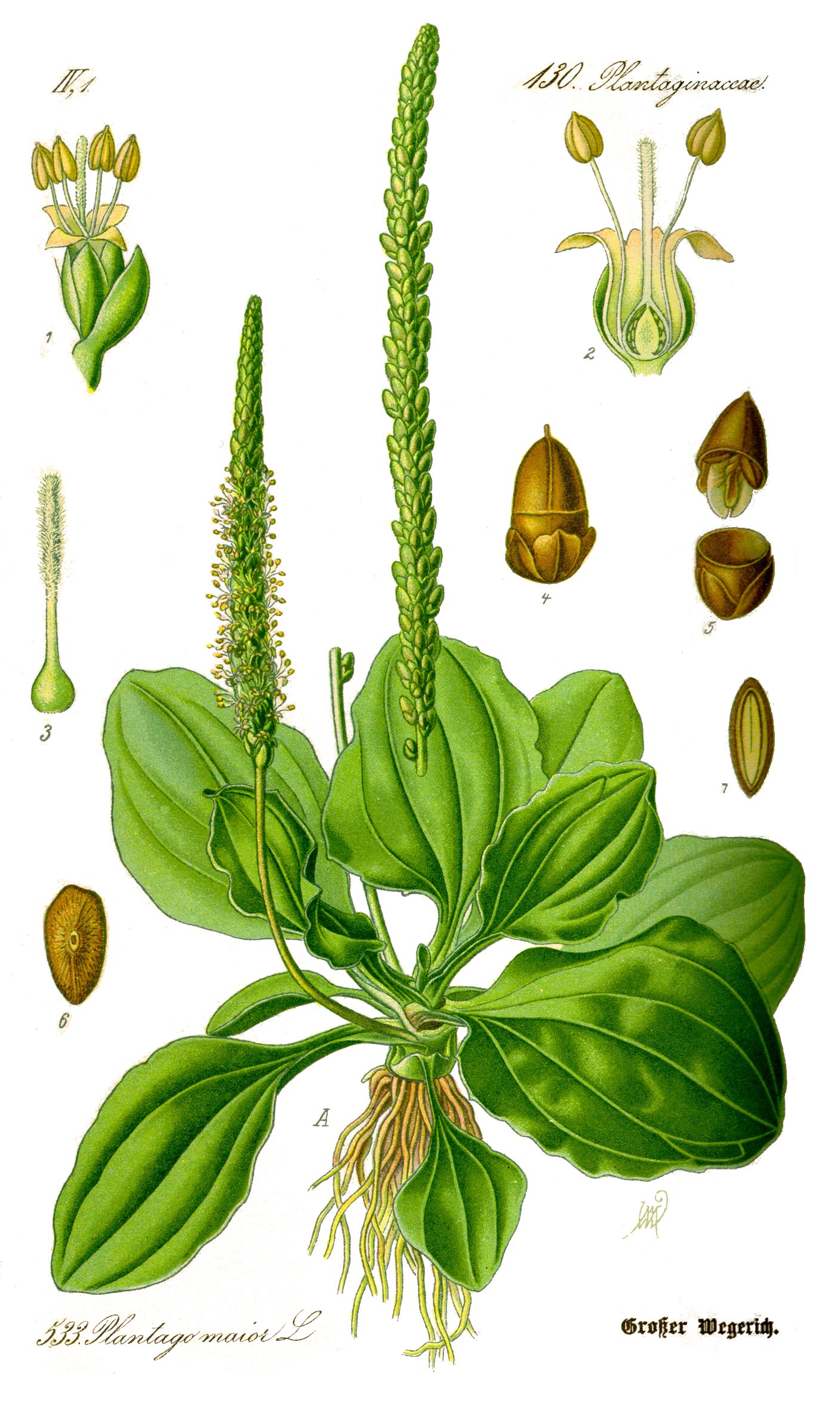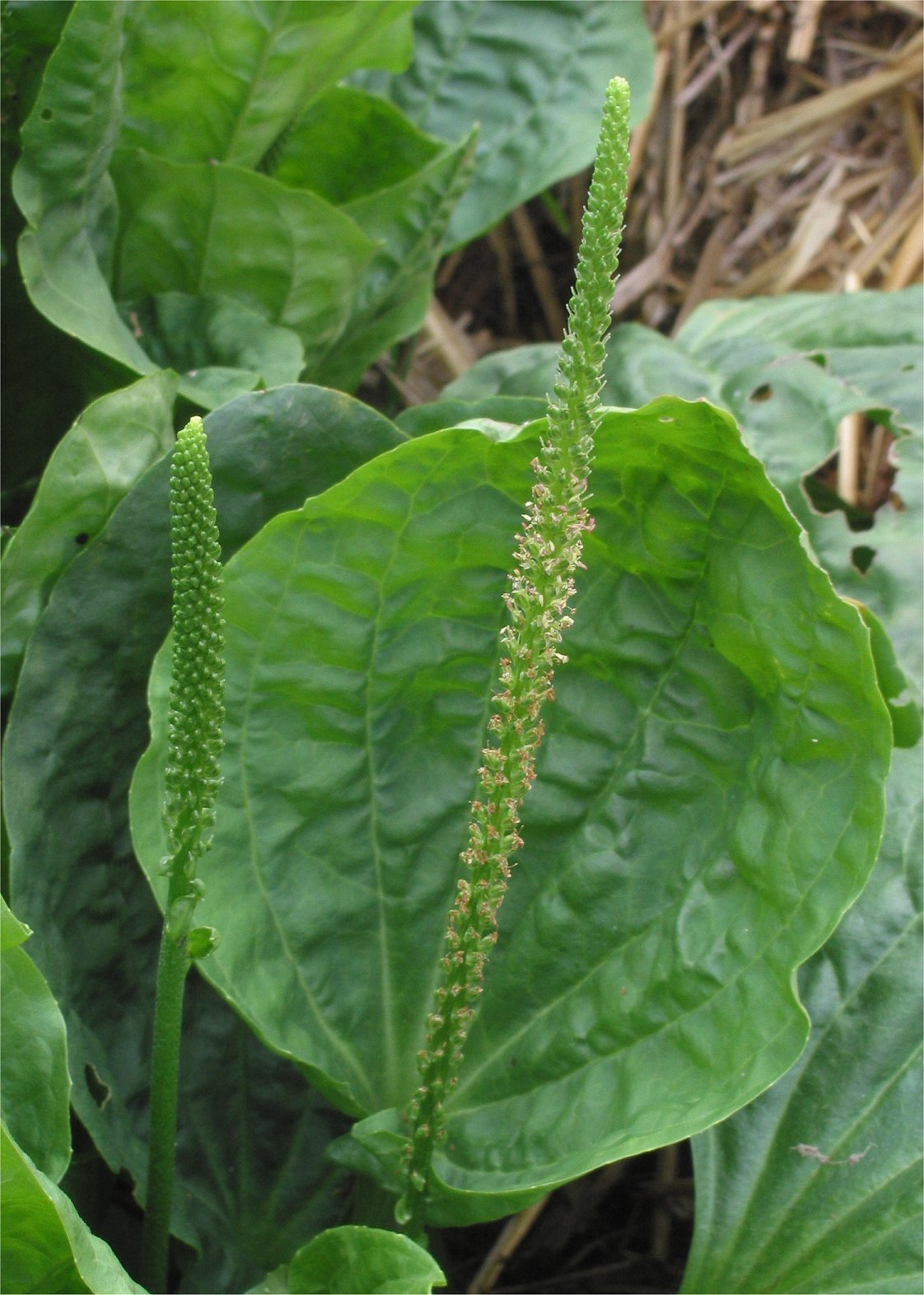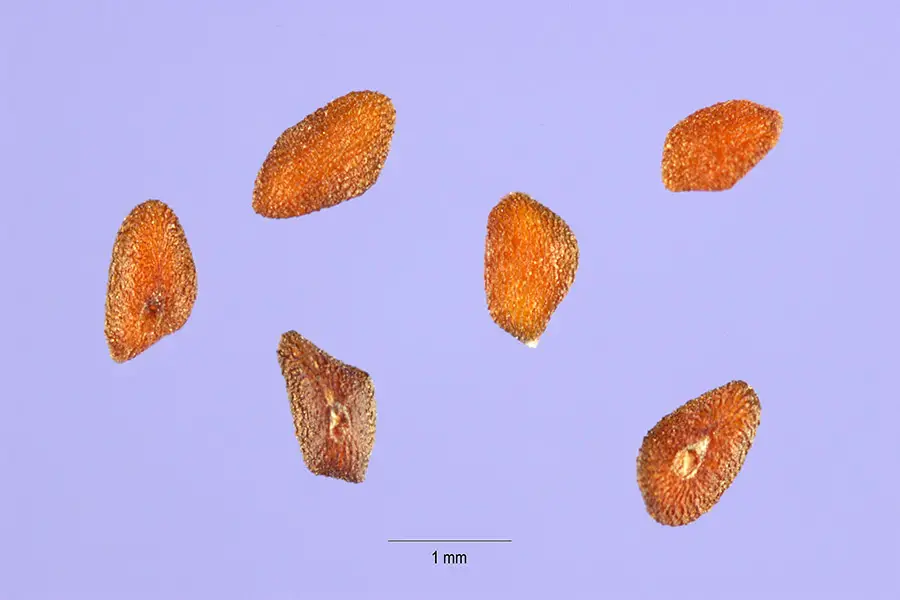
Search Wild Foods Home Garden & Nature's Restaurant Websites:
Plantain

Broadleaf Plantain, Common Plantain or Greater Plantain (Plantago major) plant. (By: Javier martin)
(NOTE: If you are not interested in growing Plantain, but just finding the plant and using it, try going to the Nature's Restaurant Online site Plantain page.)
Broadleaf Plantain, Common Plantain or Greater Plantain (Plantago major). This plant has no connection with the fruit that looks like a Banana that is also called a Plantain. It is a leafy green found in waste places, paths, lawns in full to part sun. There are many variations of the Plantain, but the best one for eating is the Broadleaf.
Is the growing of this plant compatible with Natural farming, Ecoagriculture or Eco friendly agriculture, Ecological farming, Sustainable agriculture, Agroforestry or Agro-sylviculture and Permaculture: This is a plant that does its best using Natural farming or no-till garden methods. Once started, whether on its own or in with other plants, there is no need to turn the soil. In fact, this plant takes hard, compacted soils and loosens them. See under "Maintenance" below for how to use this plant to make mud-free perennial pathways in no-till or tilled gardens.
Seeds: Plantain produces a lot of seeds on the ends of the long thin seed heads. Gather when mature when the seedhead turns from green to tan. When choosing the plants to gather the seeds from, look for the kind with the wide leaves.
Soil & Site: This plant is remarkable for its ability to grow in hard, poor soil and take abuse like being walked on over and over. So, I like to grow it between the rows of plants in the garden on the pathways. It can grow in a wide range of soil pH, types and climates. If you are growing for greens, other than turning over the soil before planting, there is nothing you need to do. If you do put some composted manure or other fertilizer in the soil, this plant can get huge.
Planting: Spread the seeds over the area you want them, tamp lightly, put over a very thin layer of fine mulch, water, and there should be no problem getting a good crop. When planting for pathways between rows, just spread a layer along the pathway between rows early in the spring when the garden has been prepared for planting. You don't have to wait for the last frost to plant this one. After spreading the seed, just tamp the soil with the back of a hoe, then spread a little mulch.
Maintenance: If you are growing a couple of these for the greens, there is nothing to do other than picking off flower heads to prevent them from turning into seedheads. This forces the energy back to the roots and into the greens so year after year you will have nice greens. Mulch around them to prevent other weeds from coming up.
When using for paths between rows in the garden, I run over it now and then with the lawn mower to keep it growing low and prevent the seedheads from coming up. If I see low seedheads forming, I just pick them to prevent this plant from becoming a weed in the garden next year. By doing this, it provides a path to walk on that is not muddy after rains or watering, plus during times of drought, this plant shades the soil and prevents the sun from baking it. In the fall or spring when you are turning over the garden (I rent a tiller for this), you can just turn these under with the rest of the garden. That way, you can move the pathways. If you like where the pathways are, you can leave this walkway crop in place (it is a perennial), and till alongside it. If you do that, start to mow it as soon as it comes back in the spring to train it to grow low. One nice thing about leaving it in place is you have well established pathways that are not mucky in the spring which makes planting the garden easier. The incredibly fibrous root systems hold the soil in place even when soaked.
Harvesting: For greens, harvest small, young leaves only. Don't use the pathway plants for this, only use the ones you left to grow upright.
Using: You can use the fresh, young leaves raw on a salad, but I have to say, I'm not really keen on them. Not bad tasting, but the chewy texture, dry/nothing taste isn't my favorite. However, used steamed or chopped up and a little in soups, or other cooked foods, it makes a good, healthy green. Not a green to serve by itself, but with others greens, or just as one of many ingredients, it is quite useful. Leaves must be young and immature, or they will be stringy.
One of the nice things about it in foods, is it has soothing qualities, and is a nice green to include with hot foods. If all you can get is stringy leaves, wash them, then boil in water and use some of the water in hot and spicy meals when cooking.
Description:
- USDA Plant Hardiness Zone: 3-9 (More information on hardiness zones).
- Soil pH: 4.6-7.8
- Plant Size: 15–30 cm (6 to 12 inches) diameter, Flower spikes can reach 50cm (20 inches) or more, but usually are 30 cm (12 inches) or less
- Duration: Perennial
- Leaf Shape: Ovate (Oval).
- Leaf Phyllotaxis (Arrangement) on branch: (rosette) of basal leaves (leaves at the base)
- Leaf Size: 5–25 cm (2 to 10 inches) long and 4–12 cm (1 1/2 to 5 inches) wide
- Leaf Margin: Entire (smooth edged), most often it is wavy
- Leaf Notes: The leaf veins (5 to 9) all start from the base of the leaf and sweep toward the tip. The veins are also obvious as they are like channels that are lower than the top of the leaf. The stem of the leaf is trough shaped. (Looking at the shape of the leaf, veins and stem, you can't help but wonder if they evolved/are designed to collect and channel water to the center of the plant to water the root in times of little precipitation.)
- Flowers: The tightly packed, small flowers are a brown tinted green on a spike 5–15 cm (2 to 6 inches ) long on a stem 10–30 cm (4 to 12 inches ) tall (in perfect conditions, sometimes significantly taller). There are usually 3 to 10 of these spikes (6 seems about average) coming from the center base of the plant.
- Fruit: Tiny yellowish tan to reddish tan oval shaped seeds with off-center pointed ends. Each plant can produce huge numbers of seeds. (Don't eat the seeds)
- Habitat: Full to part sun. Disturbed soils, compacted soils. Lawns, gardens, pathways, fields. Very often found on or along well used dirt trails as it can withstand being walked on and growing in very hard packed soil.
Web Resources:
- Recipe search on the web here (Google search) and here (Bing search).
- Pictures on the web here (Google images) and here (Bing images).
- Interactive USDA distribution map and plant profile here.
- The Biota of North America Program (BONAP) distribution map here. BONAP map color key here.

Broadleaf Plantain, Common Plantain or Greater Plantain (Plantago major) range. Distribution map courtesy of U. S. Department of Agriculture (USDA Natural Resources Service) and used in accordance with their policies.

Broadleaf Plantain, Common Plantain or Greater Plantain (Plantago major) illustration. (By: Prof. Dr. Otto Wilhelm Thomé Flora von Deutschland, Österreich und der Schweiz 1885, Gera, Germany)

Broadleaf Plantain, Common Plantain or Greater Plantain (Plantago major) leaf and flower stalk. (By: Rasbak GNU Free Documentation License, Version 1.2)
Broadleaf Plantain, Common Plantain or Greater Plantain (Plantago major) flowers up close. (By: H. Zell GNU Free Documentation License, Version 1.2)

Broadleaf Plantain, Common Plantain or Greater Plantain (Plantago major) seeds. (Steve Hurst, hosted by the USDA-NRCS PLANTS Database)
Search Wild Foods Home Garden & Nature's Restaurant Websites:
Share:
Why does this site have ads?
Originally the content in this site was a book that was sold through Amazon worldwide. However, I wanted the information to available to everyone free of charge, so I made this website. The ads on the site help cover the cost of maintaining the site and keeping it available.
Google + profile
